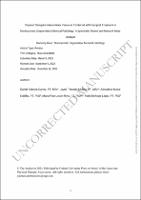Please use this identifier to cite or link to this item:
https://repositorio.usj.es/handle/123456789/1038
| Title: | Physical Therapist Interventions Versus or Combined with Surgical Treatment in Nontraumatic Degenerative Meniscal Pathology: A Systematic Review and Network Meta-Analysis (UNCORRECTED MANUSCRIPT) |
| Authors: | Solsona-Carcas, Daniel

Trenado Molina, Javier Buesa-Estelléz, Almudena 
López-Royo, María Pilar 

Bellosta-López, Pablo 

|
| Keywords: | Knee; Physical Therapy Modalities; Meniscectomy; Network Meta-Analysis; Physical Therapy Modalities |
| Issue Date: | 18-Jan-2024 |
| Citation: | Daniel Solsona-Carcas, Javier Trenado-Molina, Almudena Buesa-Estéllez, Maria Pilar López-Royo, Pablo Bellosta-López, Physical Therapist Interventions Versus or Combined with Surgical Treatment in Nontraumatic Degenerative Meniscal Pathology: A Systematic Review and Network Meta-Analysis, Physical Therapy, 2024;, pzae007, https://doi.org/10.1093/ptj/pzae007 |
| Abstract: | Objective This study aimed to synthesize the evidence from randomized clinical trials (RCTs) in people with nontraumatic degenerative meniscal pathology, comparing physical therapist interventions versus or combined with arthroscopic partial meniscectomy (APM). Methods Seven electronic databases were searched. Methodological quality was evaluated using the Physiotherapy Evidence Database scale. Data synthesis was performed with random-effects network meta-analysis, and results were summarized using the standardized mean differences. Results From 2103 studies, 10 RCTs comprising 1411 individuals were included. Ninety percent of the selected RCTs were classified as good quality according to the Physiotherapy Evidence Database scale. All interventions (physical therapist interventions, APM, and APM plus physical therapist interventions) showed reduced pain and physical impairments at 3 months follow-up. However, when a physical therapist intervention was included, greater reductions in pain at rest (APM versus physical therapist interventions: 0.73 [95% CI = 0.20 to 1.26]; APM versus APM plus physical therapist interventions: 0.59 [95% CI = 0.15 to 1.03]) and greater increases in the strength of knee extensor muscles (APM versus physical therapist interventions: 0.44 [95% CI = 0.07 to 0.80]; APM versus APM plus physical therapist interventions: 0.73 [95% CI = 0.29 to 1.16]) were observed at 3 months. In contrast, no differences were found between treatments beyond 3 months. Conclusions Physical therapist interventions based on exercise programs demonstrate superior short-term outcomes in pain reduction and knee extensor strength compared to surgical treatment. Impact For nontraumatic degenerative meniscal pathology, conservative treatment utilizing a physical therapist intervention approach should be prioritized as the first choice over surgical treatment. It offers comparable or superior short-term pain reduction and strength improvements, with a lower risk of side effects. In cases where surgery is deemed necessary, including postsurgical physical therapist interventions are highly recommended to enhance muscle strength and alleviate pain. |
| URI: | https://repositorio.usj.es/handle/123456789/1038 |
| ISSN: | 1538-6724 |
| Appears in Collections: | Artículos de revistas |
Files in This Item:
| File | Description | Size | Format | |
|---|---|---|---|---|
| Physical Therapist Interventions Versus.pdf | 1,02 MB | Adobe PDF |  View/Open |
This item is licensed under a Creative Commons License

